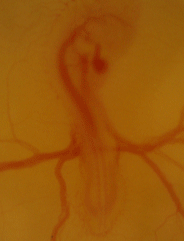SO, WHAT IS AN ANIMAL MODEL?
What is an animal model, how are they chosen, and how are they justified? Simply put, an animal model is an animal that is studied frequently and preferentially to tell us more about systems, tissues, cells and biochemical and physiological process in which we are interested. An animal quickly becomes a "model" when it is recognized as easier to study than another animal while attempting to answer a basic biological question (see Exploiting the August Krogh Principle, below). When the motivation is to understand human physiology, then an animal model may be the only acceptable approach for reasons of ethics or suitability of current experimental approaches. A prime example here is the use of embryos of the mouse, chicken, zebrafish and even the fruit fly to model those processes that we believe to be occurring during human development, but cannot reasonably investigate in humans. More pragmatically, animals also become models when their popularity builds momentum to the point that they "corner the market". Often a point is reached when so much begins to be known about a particular animal model - that is, they becomes so popular - that even more compelling potential models are no longer explored 1.
The zebrafish, Danio rerio, epitomizes the "animal model". This formerly obscure aquarium fish has risen rather meteorically as a model for studying a variety of developmental questions, now including those with a physiological basis. The zebrafish has all the hallmarks of a successful animal model in developmental physiology. It exhibits parthenogenesis, lends itself to mutagenic screens, is relatively transparent as an embryo and early larva, has a relatively rapid generation time for a vertebrate, and can be maintained and bred easily in a limited amount of space. The zebrafish also exhibits that most important property of a successful model in having "cornered the market". So much is known about the genetics and, increasingly, the physiology of embryonic and larval zebrafish that it is difficult even to contemplate rejecting so much supporting background data and beginning the study of a new model species. Yet, one could indeed argue that models more suitable than the zebrafish must surely exist. Bony fishes represent the greatest evolutionary explosion in the history of vertebrates. There are more than 20,000 living species, and one can predict that there probably exists a species of fish that has larger embryos, grows more rapidly, is more prolific, and can be kept and bred easier than currently popular zebrafish. The relatively well-known tilapia (Oreochromis) or the fathead minnow (Pimephales promelas) come close but do not achieve all of these characteristics. However, since superior piscine models are not actively being sought, and since the data on all aspects of zebrafish biology (but especially their genetics) grows almost exponentially, it is quite unlikely that even a demonstrably more superior vertebrate model could displace the zebrafish anytime soon.
Does the increasing prominence of zebrafish in developmental biology - especially in trying to determine the genetic underpinnings of physiology - mean that the emerging field of developmental physiology must make do with an "inferior" model? Most certainly not. As indicated above, when a sufficient data base exists for an animal model, this becomes one of its most compelling features, even when there might be other limitations.
Most importantly, however, and ultimately, the beauty of a model is in the eye of the beholder.
1 There are excellent examples of superior products failing to displace more popular inferior products, or at least arguably equivalent ones, in the field of consumer electronics. Consider the complex history over the last thirty years of the evolution of mass storage devices for music and movies.




